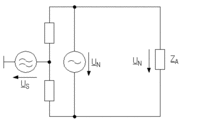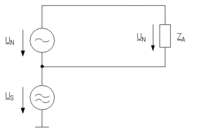Definition of common mode interference
Common mode interference is caused if an interfering voltage is coupled into both branches of a circuit. This increases the potential in the outgoing and return lines. Common mode interference current flows in the same direction as everything else on these lines. The circuit closes with the earth reference plane or with unwanted capacities.
Circuit diagrams for a symmetrically and an asymmetrically operated electrical circuit with common mode interference.
Common mode interference in a symmetrically operated electrical circuit  |
Common mode interference in an asymmetrically operated electrical circuit  |
Character definitions
Character |
Meaning |
|---|---|
US |
Interference voltage |
UN |
Wanted Voltage |
Z |
Impedance (e.g. in measurement device) |
Causes
Common mode interferences have many different causes and are coupled either inductive or capacitive:
Inductive coupling if electromagnetic fields are found in the area between the symmetrical wire pair and the ground
The transmitter of a system sends a common mode signal to a neighboring wire pair which is coupled with other pairs as direct-axis voltage components
The switching transistor housing is either at operating voltage potential or at zero depending on the clock pulse; these voltage jumps are coupled to the heat sink and therefore earth reference plane with capacitance
Common mode-differential mode-conversion
Normally, interference occurs in the form of linear or common mode voltage and only then causes an interfering differential mode signal because of insufficient symmetry.
When the impedance of the lines is uneven or if stray capacities are found, a common mode-differential mode-conversion occurs. The asymmetrical ratios then create a differential voltage which is then carried with the useful signal.
As soon as anything asymmetric occurs a coupling of the interference source to the useful load occurs.


